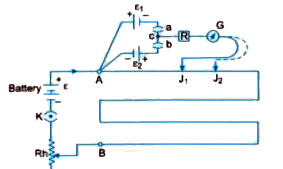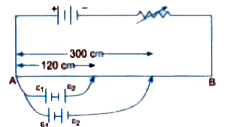How can the sensitivity of a potentiometer be increased?
To increase the sensitivity of a potentiometer, we can follow these steps:
Step 1: Understand Sensitivity
Sensitivity of a potentiometer is defined as the ability to measure small changes in voltage. It is often expressed as the potential gradient (k), which is the potential difference (V) per unit length (L) of the potentiometer wire. The formula is:
k=VL
Step 2: Identify the Relationship
From the formula, we see that the sensitivity is inversely proportional to the length of the wire. This means that if we increase the length of the wire, the potential gradient (k) will decrease, leading to increased sensitivity.
Step 3: Increase the Length of the Potentiometer Wire
To increase the sensitivity, we can increase the length (L) of the potentiometer wire. By doing this, the potential gradient (k) decreases, allowing for more precise measurements of voltage.
Step 4: Decrease the Current
Another way to increase sensitivity is to decrease the current (I) flowing through the potentiometer wire. The potential gradient can also be expressed as:
k=I⋅RL
where R is the resistance of the wire. By reducing the current, the potential gradient (k) will also decrease, leading to higher sensitivity.
Step 5: Conclusion
Thus, the sensitivity of a potentiometer can be increased by either increasing the length of the potentiometer wire or decreasing the current flowing through it. Both methods result in a lower potential gradient, which enhances the ability to measure small voltage changes.
---
Sensitivity of a potentiometer is defined as the ability to measure small changes in voltage. It is often expressed as the potential gradient (k), which is the potential difference (V) per unit length (L) of the potentiometer wire. The formula is:
k=VL
From the formula, we see that the sensitivity is inversely proportional to the length of the wire. This means that if we increase the length of the wire, the potential gradient (k) will decrease, leading to increased sensitivity.
To increase the sensitivity, we can increase the length (L) of the potentiometer wire. By doing this, the potential gradient (k) decreases, allowing for more precise measurements of voltage.
Another way to increase sensitivity is to decrease the current (I) flowing through the potentiometer wire. The potential gradient can also be expressed as:
k=I⋅RL
where R is the resistance of the wire. By reducing the current, the potential gradient (k) will also decrease, leading to higher sensitivity.
Thus, the sensitivity of a potentiometer can be increased by either increasing the length of the potentiometer wire or decreasing the current flowing through it. Both methods result in a lower potential gradient, which enhances the ability to measure small voltage changes.
Topper's Solved these Questions
- CURRENT ELECTRICITYBOOK - MODERN PUBLICATIONCHAPTER - CURRENT ELECTRICITYEXERCISE - REVISION EXERCISES (ADDITIONAL QUESTIONS)
11 Videos
- CURRENT ELECTRICITYBOOK - MODERN PUBLICATIONCHAPTER - CURRENT ELECTRICITYEXERCISE - REVISION EXERCISES (FILL IN THE BLANKS)
10 Videos
- CURRENT ELECTRICITYBOOK - MODERN PUBLICATIONCHAPTER - CURRENT ELECTRICITYEXERCISE - HIGHER ORDER THINKING SKILLS & ADVANCED LEVEL
10 Videos
- ATOMS BOOK - MODERN PUBLICATIONCHAPTER - ATOMS EXERCISE - Chapter Practice Test
16 Videos
- DUAL NATURE OF RADIATION AND MATTER BOOK - MODERN PUBLICATIONCHAPTER - DUAL NATURE OF RADIATION AND MATTER EXERCISE - CHAPTER PRACTICE TEST
15 Videos
Similar Questions
A student uses the circuit diagram of a potentiometer as shown in Fig.

(a) For a steady current I passing through the potentiometer wire, he gets a null point for the cell ε1and not for ε2 . Give reason for this observation and suggest how this difficulty can be resolved.
(b) What is the function of resistance R used in the circuit? How will the change in its value affect the null point ?
(c ) How can the sensitivity of the potentiometer be increased?
View SolutionIn the figure a long uniform potentiometer wire AB is having a constant potential gradient along its length. The null points for the two primary cells of emfs ε1 and ε2 connected in the manner shown are obtained at a distance of 120 cm and 300 cm from the end A. Find (i) ε1/ε2 and (ii) position of null point for the cell ε1.
How is the sensitivity of a potentiometer increased ?

View Solution
Knowledge Check
The sensitivity of a potentiom eter is increased b y
Aincreasing the emf of the cell.Bincreasing the length of the potentiometer wire.Cdecreasing the length of potentiometer wire.Dnone of the above.Sensitivity of potentiometer can be increased by
AIncresing the e.m.f. of the cellBIncreasing the length of the potentiometer wireCDecreasing the length of the potentiometer wireDNone of the aboveThe sensitivity of the potentiometer can be increased by
Aincreasing the length of the wireBincreasing the e.m.f. of the cellCdecreasing the length of the wireDnone of these
In the Fig., a long uniform potentiometer wire AB is having a constant potential gradient along its length. The null points for the two primary cells of emf ε1 and ε2 connected in the manner shown are obtained at a distance of 120 cm and 300 cm from the end A. Find (i)ε1/ε2 and (ii) position of null point for the cell ε1. How is the sensitivity of a potentiometer increased ?

View SolutionWhich of the following operations will not increase the sensitivity of a potentiometer?
View SolutionWhy is a lactometer more sensitive than a normal hydrometer ? Explain how the sensitivity of a hydrometer can be increased.
View SolutionSensitivity of a potentiometer can be increased by ______the length of potentiometer wire.
View SolutionThe sensitivity of a tangent galvanometer increases if
View Solution
